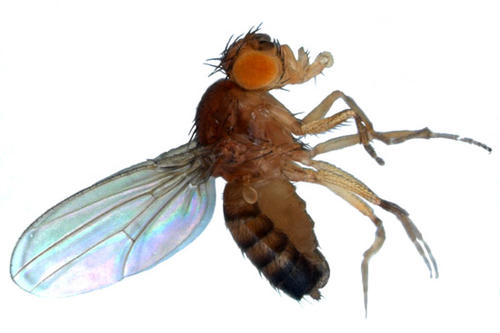“Lock Gate” Remains Closed
Fruit Flies Provide Researchers with Evidence of Possible Cause of Autism in Humans
№ 193/2010 from Jun 14, 2010
Neurobiologists study fruit fly Drosophila melanogaster
Image Credit: Westfälische Wilhelms-Universität Münster – Banovic
In a specially bred fruit fly of the species Drosophila melanogaster, the structure of the connections between nerve and muscle is disturbed by a genetic defect. A tiny mutation destroys the building instructions for a protein from the family of so-called neuroligins. This was discovered by researchers at Westfälische Wilhelms-Universität (WWU) Münster and Freie Universität Berlin. They say their findings will also have significance for humans.
In humans, neuroligins have been associated primarily with autism. Up to now, it was not possible to detect drastic changes at the cellular level and at nerve synapses. “That is why the new findings are so exciting,” emphasized Prof. Hermann Aberle, a neurobiologist from Münster. “This is the first evidence to indicate that the lack of social behavior in autism patients may be caused by structural defects at nerve synapses.”
Normally synapses release chemical messengers on the presynaptic side, when they are excited by an electrical nerve impulse. At neuromuscular junctions, i.e., at interfaces between nerve and muscle, these neurotransmitters drift to muscle membrane on the opposite postsynaptic side, causing a muscle contraction. The teams around Prof. Hermann Aberle from the Institute of Neurobiology of WWU and Prof. Stephan Sigrist from Freie Universität Berlin have recently reported in the prestigious journal Neuron that neuroligins are involved in the formation of the postsynaptic domain. If a neuroligin gene is defective, often the strength of the synaptic transmission is reduced by half. Neurotransmitters cannot travel in an orderly fashion, and the electrical communication between nerve and muscle cells is disturbed. “It is as if a ship gets stuck in a lock because the second lock gate no longer rises,” explains Hermann Aberle. However, communication at the nerve synapses of the fruit flies does not come to a complete standstill. The affected animals are viable, although they are somewhat weaker than their peers.
Autism is a relatively common mental disorder that affects approximately every 200th baby. The developmental disorder is accompanied by delayed language development and a lack of social behavior. It is now known that genetic factors play a role in the development of this disease. In 2003 the French researcher, Thomas Bourgeron, was the first to bring defective neuroligin genes in connection with autism. Hermann Aberle and Stephan Sigrist assume that their most recent observations can be applied to autism patients, as both the functioning and structure of the nerve synapses in the investigated flies are quite similar to the interconnections between nerve cells in the human brain. “Future experiments could clarify this. Thanks to the fruit fly there is now, for the first time, evidence to build on,” said Daniel Banovic, coauthor from Münster.
The flow of information in networks of nerves is controlled mainly by changes in the activity of synapses. The amount of released neurotransmitter is proportional to stimulus intensity. It thereby controls strengthening or weakening of synaptic activity. Strongly excited nerve synapses are strengthened structurally, while rarely used synapses are gradually removed. “It is now believed that dynamic plasticity plays a crucial role in the permanent storage of what has been learned,” said Hermann Aberle. Since electrical activity can only be transmitted in part if the neuroligin gene is defective, it is possible that in such cases the plasticity mechanisms are overridden and the balance between strong and weak synapses is changed over the long term. It is possible that a shift in the synaptic balance is the trigger for behavioral disorders in autism patients.

